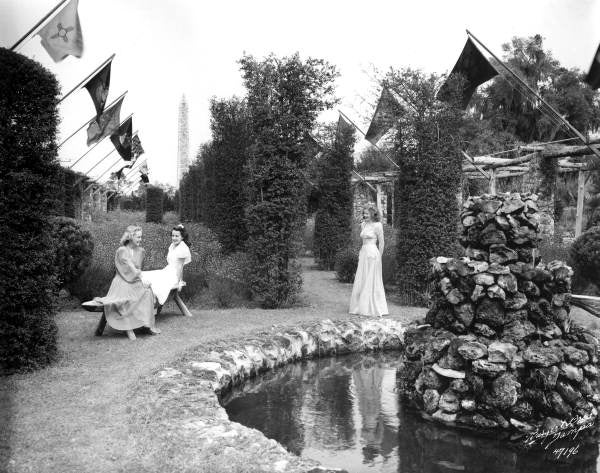
History
Ravine Gardens State Park is a 152-acre park located in Palatka, Florida. The park contains steephead ravines surrounding Whitewater Branch, a spring-fed stream that flows east into the St. Johns River. The ravines slope down to the branch, with maximum elevations of 70 to 120 feet. Unlike ravines that are created by surface erosion, steephead ravines are the result of seeping underground water which undercuts the sandy slopes, causing them to collapse. Native vegetation in the ravines would range from bays, hollies and native azaleas on the lower slopes to dogwoods, magnolias, laurel oaks and live oaks on the upper slopes. Today, the vegetation is a mix of native species and ornamentals, primarily azaleas, introduced during the 1930s development of the gardens.
In 1853, the year Palatka was incorporated, the city was a growing trade center on the river and prime spot for winter tourism. Between 1865 and 1895, Palatka became known as the “Gem City of the St. Johns.” It became a major port, rivaling Jacksonville for dominance of trade on the river. Palatka was experiencing a golden age. The area’s citrus crops and lumber industry were booming. Trains loaded with agricultural products steamed out of the city on five newly built railroad lines. However, at the end of the 19th century, a major citrus freeze brought Palatka's golden age to a close.
By 1933, Palatka was suffering the effects of the Great Depression. A local paving contractor named Thomas Byrd Gillespie wrote that Palatka was a “prosperous community transformed by a depression into a section having many actually hungry and in dire distress.” At the time, Gillespie was a member of a three-person county committee appointed by the governor to use federal relief money for public works employment. He recognized that tourism was becoming an important economic force in Florida. He saw that other Florida cities with "something worthwhile for [people] to stop and see” were attracting hundred of visitors. From this observation, the idea of Ravine Gardens was born.

Gillespie enjoyed gardens and natural beauty, and he knew many tourists were drawn to Florida by its tropical landscapes. He envisioned the development of the ravines formed by Whitewater Branch into a formal garden. Using his own funds, he paid landscape architect Richard Forester to create a plan for the gardens. When it was complete, Gillespie went to city officials with his idea. According to the Palatka Daily News, the plan was enthusiastically received at the commission meeting and was eagerly approved. By the end of March, a Civil Works Administration (CWA) allotment of $161,785 had been made for the proposed ravines project and work began using Federal Emergency Relief Act (FERA) workers. Forester’s plan was presented in April calling “for construction of an administration building, concessions building, entrance station, limestone fountain and gardens, restoration of the mill suspension bridges, the building of dams, rustic benches and a sprinkler system, terracing and construction of retaining walls, and improvement of existing roads.”
The gardens were officially opened on the July 4, 1933. By the end of 1933, the ravine activities had become so extensive that CWA administrative offices sent Julius F. Stone to inspect Florida projects and “to discern what was being done with 40,000 azaleas.” Apparently, the results were impressive because Stone “promptly recommended a larger allotment for the continuance of work and became one of the garden’s most enthusiastic supporters.” In November of 1933, the CWA announced that the gardens would receive a $150,000 allotment to continue and two days later 300 men were at work on the project. By the end of 1933, however, the city was again petitioning FERA “for additional funds for materials and labor to continue ravine improvements.” By May of 1934, the project was again plagued by a shortage of funds, a pattern that would continue over the next couple of years.
In 1935, the Works Progress Administration had taken over the FERA projects. The WPA announced that $56,000 was being allocated to the garden. During 1936, the WPA allotted additional funding for the gardens to support a park superintendent, two foremen and 49 laborers. Later in the same year, 50 additional employees were added. Presumably the WPA funding also supported the continued planting of over 270,000 plants on the slopes of the ravines. World War II brought an end to the WPA, as well as an end to the construction in the gardens. The city of Palatka continued to promote, maintain and develop the facilities around the gardens.
However, as the 1960s ended, management of the gardens became increasingly difficult and expensive for the city, resulting in the closure of the park. In 1969 the city offered a proposal to the state to acquire the gardens as part of the state park system. In January 1970, the gardens were deeded to the Florida Internal Improvement Trust Fund and Ravine Gardens officially became a Florida State Park. Ravine Gardens State Park is one of the nine New Deal-era state parks in Florida.